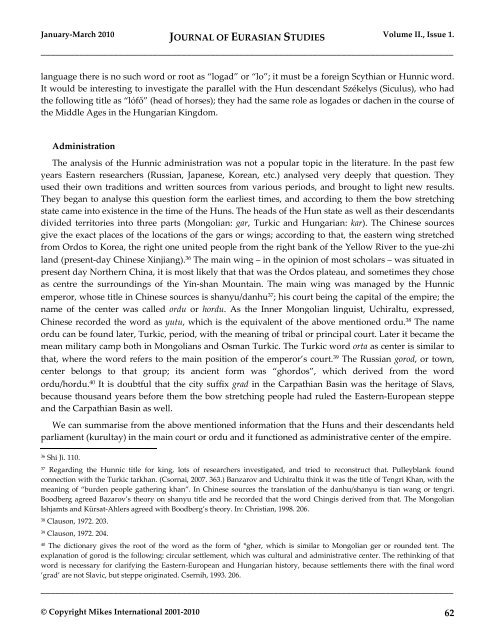EurasianStudies_0110..
EurasianStudies_0110..
EurasianStudies_0110..
You also want an ePaper? Increase the reach of your titles
YUMPU automatically turns print PDFs into web optimized ePapers that Google loves.
January-March 2010 JOURNAL OF EURASIAN STUDIES Volume II., Issue 1.<br />
_____________________________________________________________________________________<br />
language there is no such word or root as “logad” or “lo”; it must be a foreign Scythian or Hunnic word.<br />
It would be interesting to investigate the parallel with the Hun descendant Székelys (Siculus), who had<br />
the following title as “lófő” (head of horses); they had the same role as logades or dachen in the course of<br />
the Middle Ages in the Hungarian Kingdom.<br />
Administration<br />
The analysis of the Hunnic administration was not a popular topic in the literature. In the past few<br />
years Eastern researchers (Russian, Japanese, Korean, etc.) analysed very deeply that question. They<br />
used their own traditions and written sources from various periods, and brought to light new results.<br />
They began to analyse this question form the earliest times, and according to them the bow stretching<br />
state came into existence in the time of the Huns. The heads of the Hun state as well as their descendants<br />
divided territories into three parts (Mongolian: gar, Turkic and Hungarian: kar). The Chinese sources<br />
give the exact places of the locations of the gars or wings; according to that, the eastern wing stretched<br />
from Ordos to Korea, the right one united people from the right bank of the Yellow River to the yue-zhi<br />
land (present-day Chinese Xinjiang). 36 The main wing – in the opinion of most scholars – was situated in<br />
present day Northern China, it is most likely that that was the Ordos plateau, and sometimes they chose<br />
as centre the surroundings of the Yin-shan Mountain. The main wing was managed by the Hunnic<br />
emperor, whose title in Chinese sources is shanyu/danhu 37 ; his court being the capital of the empire; the<br />
name of the center was called ordu or hordu. As the Inner Mongolian linguist, Uchiraltu, expressed,<br />
Chinese recorded the word as yutu, which is the equivalent of the above mentioned ordu. 38 The name<br />
ordu can be found later, Turkic, period, with the meaning of tribal or principal court. Later it became the<br />
mean military camp both in Mongolians and Osman Turkic. The Turkic word orta as center is similar to<br />
that, where the word refers to the main position of the emperor’s court. 39 The Russian gorod, or town,<br />
center belongs to that group; its ancient form was “ghordos”, which derived from the word<br />
ordu/hordu. 40 It is doubtful that the city suffix grad in the Carpathian Basin was the heritage of Slavs,<br />
because thousand years before them the bow stretching people had ruled the Eastern-European steppe<br />
and the Carpathian Basin as well.<br />
We can summarise from the above mentioned information that the Huns and their descendants held<br />
parliament (kurultay) in the main court or ordu and it functioned as administrative center of the empire.<br />
36 Shi Ji. 110.<br />
37 Regarding the Hunnic title for king, lots of researchers investigated, and tried to reconstruct that. Pulleyblank found<br />
connection with the Turkic tarkhan. (Csornai, 2007. 363.) Banzarov and Uchiraltu think it was the title of Tengri Khan, with the<br />
meaning of “burden people gathering khan”. In Chinese sources the translation of the danhu/shanyu is tian wang or tengri.<br />
Boodberg agreed Bazarov’s theory on shanyu title and he recorded that the word Chingis derived from that. The Mongolian<br />
Ishjamts and Kürsat-Ahlers agreed with Boodberg’s theory. In: Christian, 1998. 206.<br />
38 Clauson, 1972. 203.<br />
39 Clauson, 1972. 204.<br />
40 The dictionary gives the root of the word as the form of *gher, which is similar to Mongolian ger or rounded tent. The<br />
explanation of gorod is the following: circular settlement, which was cultural and administrative center. The rethinking of that<br />
word is necessary for clarifying the Eastern-European and Hungarian history, because settlements there with the final word<br />
’grad’ are not Slavic, but steppe originated. Csernih, 1993. 206.<br />
_____________________________________________________________________________________<br />
© Copyright Mikes International 2001-2010 62

















